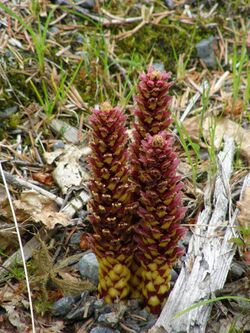Biology:Boschniakia rossica
| Boschniakia rossica | |
|---|---|

| |
| Scientific classification | |
| Kingdom: | Plantae |
| Clade: | Tracheophytes |
| Clade: | Angiosperms |
| Clade: | Eudicots |
| Clade: | Asterids |
| Order: | Lamiales |
| Family: | Orobanchaceae |
| Genus: | Boschniakia |
| Species: | B. rossica
|
| Binomial name | |
| Boschniakia rossica | |
| Synonyms[1] | |
| |
Boschniakia rossica, commonly known as the northern groundcone, is a holoparasitic plant that lives in the northern latitudes of the northern hemisphere. In the Pacific Northwest Temperate Rainforest, it does not grow south of Prince of Wales Island, beyond that boundary is the Vancouver groundcone habitat. It does not contain chlorophyll, so it must be parasitic to obtain nutrients. It specializes on Alnus species, but can parasitize off of other trees and shrubs such as on Betula (birch), Salix (willow), Vaccinium (blueberry), Picea (spruce), and Chamaedaphne (leatherleaf shrub). This organism is likely to be found at mid elevations alongside rivers and streams, where moisture is abundant. This species propagates itself through water flow. In some places bears are known to have eaten the starchy roots, or tubers, of this plant.
Morphology
Boschniakia rossica grows between six and twelve inches tall, with two or three stems per individual. It has tall slender stalks. The roots grow horizontally from a main bulbous mass. It can vary from very dark maroon to reddish brown in color. This is a perennial plant, and flowers every summer. It can produce up to 300,000 seeds. B. rossica very much looks like a pine cone growing up out of the ground.
Common names
- Poque
- Cao-cong-rong (China)
- Oniku (Japan)
- Orinamudcobusali (Korea)
- Du’iinahshèe (Gwichya Gwich'in)
- Doo’iinahshìh/Tsʼeedichi (Teetå'it Gwich'in)
- Dotsonʼ ggooneeggeʼ (Koyukon, Lower & Central dialects)
- Dotsonʼ chʼecheneʼ (Koyukon, Upper dialect)
- Tulukkam nauligaafa (Inuit)
- Uktschutsch (Kamtschadalis)
Taxonomy
Genetic analyses have been conducted on B. rossica to determine its phylogeny. There are many ways to phylogenetically classify B. rossica, but scientists from Ohio State University have determined that the family Orobanchaceae is estimated to have originated about 52.2 million years ago.[2] The strongest bootstrap support is for terminal clades. The most parsimonious tree of Boschniakia forms a grade with Conopholis and Epifagus as well as other species of Orobanche. In this tree, Lindenbergia and Schwalbea are sister taxa. These are still hypotheses, and further research is being conducted.
There are two GenBank numbers referring to Boschniakia rossica: AY911214, and rps2;ITS : DQ403779; AY911214.
Synonyms
The following species are considered synonyms to Boschniakia rossica:
- Boschniakia glabra (C.A. Mey. ex Bong.)[citation needed]
- Orobanchae glabra (C.A. Mey. ex Bong.) Hook.[citation needed]
- Orobanchae rossica Cham. & Schltdl.[1]
References
- ↑ Jump up to: 1.0 1.1 "Boschniakia rossica (Cham. & Schltdl.) B.Fedtsch.". Plants of the World Online. Royal Botanic Gardens, Kew. https://powo.science.kew.org/taxon/urn:lsid:ipni.org:names:35171-2.
- ↑ Wolfe et al. 2005.
- Guo, Ji-Xian; Kimura, Takeatsu; But, Paul P. H. et al., eds (2001). International Collation of Traditional and Folk Medicine. v.4. River Edge, NJ: World Scientific.
- Kruckeberg, A R (1983). "Temperate Floras: The North Pacific Connection". Annals of the Missouri Botanical Garden 70 (4): 591–596. doi:10.2307/2398978. https://www.biodiversitylibrary.org/part/31101.
- Park, Jeong-Mi; Manen, Jean-François; Colwell, Alison E.; Schneeweiss, Gerald M. (2008). "A plastid gene phylogeny of the non-photosynthetic parasitic Orobranche (Orobanchaceae) and related genera". Journal of Plant Research 121 (4): 365–376. doi:10.1007/s10265-008-0169-5. PMID 18483784.
- Qu, Baihong; Li, Wei; Chen, Yanqiu; Liu, Jisheng (15 July 2011). "Protection versus culture-driven exploitation of wild plant resources: the case on Changbai Mountain". International Journal of Sustainable Development & World Ecology 18 (5): 404–411. doi:10.1080/13504509.2011.577196.
- Quan, Jishy; Piao, Long; Xu, Huixian; Li, Tian; Yin, Xuezhe (2009). "Protective effect of iridoid glucosides from Boschniakia rossica on acute liver injury induced by carbon tetrachloride in rats". Biosci. Biotechnol. Biochem. 73 (4): 849–854. doi:10.1271/bbb.80757. PMID 19352025.
- Wang, Zhenghui; Wu, Baojun; Zhang, Xianghong; Xu, Min; Chang, Huimin; Lu, Xiaoyun; Ren, Xiaoyong. "Purification of a polysaccharide from Boschniakia rossica and its synergistic antitumor effect combined with 5-Fluorouracil". Carbohydrate Polymers 212: 31–35.
- Wolfe, Andrea D; Randle, Christopher P; Liu, Liang; Steiner, Kim E (2005). "Phylogeny and Biogeography of Orobanchaceae". Folia Geobotanica 40 (2–3): 115–134. doi:10.1007/bf02803229.
- Yin, Zong Zhu; Jin, Hai Ling; Yin, Xue Zhe; Li, Tian Zhu; Quan, Ji Shu; Jin, Zeng Nan (2000). "Effect of Boschniakia rossica on expression of GST_P, p52 and p21ras proteins in early stage of chemical hepatocarcinogenesis and its anti-inflammatory activities in rats". World Journal of Gastroenterology 6 (6): 812–818. doi:10.3748/wjg.v6.i6.812. PMID 11819701.
- Zhang, Zhi-Yun; Tzvelev, Nikolai N. (1998). "Orobanchaceae". Flora of China. v.18. p. 239. http://www.efloras.org/florataxon.aspx?flora_id=2&taxon_id=200021452. Retrieved December 8, 2013.
External links
| Wikimedia Commons has media related to Boschniakia rossica. |
- Boschniakia rossica on Orobanchaceae Wiki
- Boschniakia rossica on Project Noah
- Boschniakia rossica from the Flora of British Columbia
Wikidata ☰ Q6048518 entry
 |

